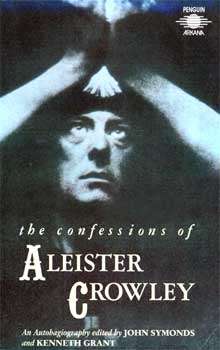The Confessions of Aleister Crowley

The Confessions of Aleister Crowley : An Autohagiography, by Aleister Crowley (1875–1947), is a partial autobiography by poet and occultist Crowley. It covers the early years of his life up until the mid-late 1920s but does not include the latter part of Crowley's life and career between then and his death in 1947.
Mandrake Press published the first two sections as separate volumes under the title ''The Spirit of Solitude'' in 1929.
Crowley had originally intended that the work would be published in six volumes, but only two of these had been published before the Great Depression and various internal disputes led to the demise of the publishers. The project languished uncompleted throughout Crowley's lifetime, and it was not until 1969 that the Confessions were issued in a single volume edition, edited by John Symonds and Kenneth Grant. Whilst the single volume edition includes much of the text of the first two volumes (and of course that of the latter four) it is nonetheless an abridgement. These original volumes include a considerable amount of text, and many photographs – particularly pertaining to Crowley's travels and mountaineering exploits – that were not reproduced in the later single volume.
It is subtitled "An Autohagiography" which refers to the autobiography of a Saint, a title which Crowley would also have associated with the Plymouth Brethren, who use it to refer to themselves. Crowley was brought up by his parents as a member of the Plymouth Brethren.[1] While Crowley considered himself in many ways to be as holy as any Christian saint, his subtitle is also reflective of his usual mischievous humour. Hagiographies are usually written about the lives of saints by others. For someone to write an "Autohagiography" is otherwise unheard of, as Crowley well knew.
The Ordo Templi Orientis will issue a new unabridged version of Confessions which will contain a great many previously unseen photographs and some new research. It will be issued in separate volumes set out and laid out to match the 1929 Mandrake press first edition typographically, and will use a binding and paper of similar quality. The new edition will incorporate much of the research done on Crowley in recent years by such scholars as Richard Spence, Richard Kaczynski and Tobias Churton for their Crowley biographies.
Contents
- Towards the Golden Dawn
- The Mystical Adventure
- The Advent of the Aeon of Horus
- Magical Workings
- The Magus
- At the Abbey of Thelema
Description
The Confessions provides Crowley's own point of view on the many incidents of the first half of his eventful life. There are long descriptions of several mountaineering expeditions to exotic places such as the Himalayas. From his early years of being raised by fundamentalist Christians (his own mother nicknamed him The Beast, after the Beast in the Biblical Book of Revelation) Crowley describes how he became a rebel against conventional religion and how his often outlandish behaviour and conflicts with authority figures contributed to his reputation as a dark magician. He does not deny dabbling with demonic forces, yet his memoirs reveal that his aim was the progress and spiritual freedom of humanity. Crowley's complex character is revealed in "The Confessions" and he naturally displays bias towards his own points of view (for instance, in defending his actions in such incidents as the disastrous expedition to Kachenjunga, and his abandonment of his first wife Rose Kelly in the Near East).
Despite the fact that the volume only covers part of Crowley's life (the material was all written by the late 1920s, when Mandrake Press issued the first two sections in hardcover), the one-volume edition is over 900 pages long. Crowley often refers to associates and enemies by their magickal names, which makes the cast of characters challenging to follow. His account of his actions in America during World War I, where he was accused of spying for the Germans (but insisted he was really a double agent for the British and Americans) is especially sketchy. On the other hand, he gives some very intelligent (if often condescending) commentaries on many societal issues. Crowley was independently wealthy, and published his many volumes of prose and poetry in lavish editions, exhausting his wealth via both this means and via extensive travel and luxuriant living under varied pseudonyms and assumed identities. In consequence, there were stages of his life in which he and those around him were penurious in the extreme, such as the time at his Abbey of Thelema at Cefalu, Sicily. Crowley led a very bohemian existence, was married more than once, and had innumerable mistresses, of whom some were magical partners designated by him as "Scarlet Women". He was also bisexual and had love affairs with men in his university days and later. The Confessions reveals all from Crowley's point of view. The Confessions is an important volume in delineating the life and opinions of one of the most famous (or infamous) magicians of the twentieth century.
Editions
- Penguin (Non-Classics). Reprint edition, 5 December 1989. ISBN 0-14-019189-5
- Routledge & Kegan Paul. Corrected ed edition, 1979. ISBN 0-7100-0175-4
See also
References
- ↑ Pamela V. Cullen, "A Stranger in Blood: The Case Files on Dr John Bodkin Adams", London, Elliott & Thompson, 2006, ISBN 1-904027-19-9
- The Desk Reference, A Guide to the Works of Edward Aleister Crowley.